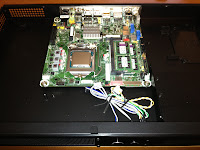After messing around with massive cased x86 home theater PCs and Android media devices that aren't quite there yet, the goal was to assemble a slim, x86-based HTPC that is overkill for everything but gaming. This build is specifically designed around the low-profile Mini-ITX form factor as adopted by Intel and SilverStone.
- Case: SilverStone PT12B super slim Mini-ITX
- Motherboard: Intel DQ77KB low profile Mini-ITX
- CPU: Intel Core i3-3225 Ivy Bridge 3.3GHz dual-core
- Cooling: Intel HTS1155LP CPU cooler
- Memory: Kingston KHX1600C9S3P1K2/8G DDR3 1600 SO-DIMM
- Primary Storage: Mushkin MKNSSDAT120GB-DX mSATA
- Secondary Storage: OCZ Agility 3 60GB SSD
- Power Supply: Antec SNP90 slim notebook power adapter
Let's start with the SilverStone PT12B case, because that's where I started with this build. One look at this case and I knew this was the form factor I wanted.
I'm an old Mini-ITX guy, starting from the ancient VIA boards. I first became aware of low-profile Mini-ITX with Intel's Johnstown Atom board. Johnstown and an M350 case was tiny server perfection. I'm so glad Intel has taken this form factor to the next level with Socket 1155 support.
The SilverStone case pictured above is really small and cleanly designed. The case front from left to right is: air intake, power switch, reset switch, power LED, HDD LED, slim DVD bay. There's no front USB, audio, FireWire, or labeling. Clean is how I like it. This is reflected on the inside of the case as well. This requires an external 19V DC power brick that connects into the back of the motherboard, so there's no internal power supply, only the brick and DC to DC conversion on the motherboard itself. The left side of the case is specifically designed for Intel's HTS1155LP heat pipe, heat sink, and blower assembly. This seems to cool my 55W TDP Core i3 well enough. I don't think I'd try a >65W TDP CPU in this form factor. The Antec 90W external power brick is tiny and works great.
See how tiny and clean the motherboard with CPU and RAM look in this already very small case.
I can hardly imagine an easier Mini-ITX build or, indeed, any PC build. The Intel CPU cooling solution has a back plate that needs to go under the motherboard. The Intel-supplied blower fan mounting screws don't work in the SilverStone holes. Luckily, SilverStone supplies smaller screws that work just fine. You will definitely want a tiny phillips head screwdriver. Below are pictures of the installed cooler and fully cabled system. This is without the mSATA drive, as the mounting screws come installed and require (yet again) a tiny phillips screwdriver I needed to retrieve from elsewhere.
Installing Windows 8 via external USB DVD drive went flawlessly. Linux is my true love, but this system will be Windows for maximum compatibility with Flash and Silverlight video. I also run a MythTV and video storage backend on Linux, so I'm expecting this box to spend a lot of time in XBMC.
This is my first experience with Windows 8. The install was very quick and smooth. Setting up my secondary SSD was infuriating as management apps are hidden. Searching for "disk" helped not at all. One must simply type Windows-R and enter "diskmgmt.msc". Easy! ;-P Microsoft has both dumbed things down and made things less intuitive with separate Start and Desktop modes and hot corners. Do I miss the Start menu even though I used to hate it? Hell yes! The sad part is, I feel like it would have been almost trivial for Microsoft to produce a touch-friendly but not desktop-averse shell. Hot corners are an "expert" feature that have been forced as a default.
This is also my first experience actually using Intel HD graphics for anything at all intensive. My CPU features the more capable HD 4000. Newer games like Borderlands 2 are borderline playable at lower quality 720p. Older games like L4D2 are quite playable at 720p. Basically, high end Intel graphics are a 720p, low to medium quality gaming solution. This machine will spend most of its life streaming video at 1080p (or less), and for that it should work splendidly. This is an expensive solution for that, but a lower spec CPU and smaller SSD would work fine for HTPC use.









No comments:
Post a Comment